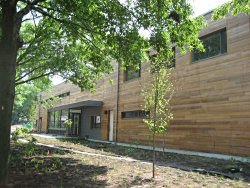National Association of State Park Directors Annual Conference, Williamsburg, VA
September 4-7, 2007
Greening the Heartland, Kansas City, MO
September 12-14, 2007
|
| eFact |
Suped-up Soil
The USDA estimates that American farmers apply 67 million pounds of nitrogenous fertilizer to the land daily.
source: Dave Praeger, “Scatologically Correct,” New York Times, April 15, 2007 |
| Also of Interest |
Restroom Reading
Clivus was featured in the spring issue of American Trails. You can read the full article on the web at www.americantrails.org under the “Resources & library” heading. Also check out the July issue of Recreation Management for a profile of the Bronx Zoo’s new Eco-Restroom, which uses Clivus systems exclusively. And be sure to pick up a copy of Dave Praeger’s new book, Poop Culture: How America is Shaped by its Grossest National Product. The book devotes a full chapter to the environmental impact of the toilet.
Maintenance Services
Did you know that Clivus can arrange to provide your facility with composting system maintenance services? Clivus offers a variety of maintenance options to meet your needs. No matter where your facility is located, we’ll come to you or work with local subcontractors to ensure that the job is done right. Call us at 800-425-4887 for more information. |
|
We’re Back!
This season’s Natural Solution News shows off the diversity of Clivus compost toilet applications. First, we describe the administrative offices of Queens Botanical Garden, a 16,000 square foot urban structure. Then we feature the Clivus M54 Trailhead compost toilet, which is a composter and building package, designed especially for remote locations. Together, these examples demonstrate the flexibility of Clivus compost toilet systems.
The Queens Master Plan
 |
| Queens Botanical Garden's new Visitor/Administration Building |
Located in the densely populated Flushing neighborhood of Queens, New York, around the corner from the Mets’ Shea Stadium, the city-owned Queens Botanical Garden provides visitors with a welcome reprieve from the usual sights and sounds of city life. The Garden describes itself as a place “where people, plants, and cultures meet.” And while the Garden has a reputation for expressing remarkable cultural and horticultural diversity in its displays, it is also building a reputation for its efforts to protect the environment. Garden management understands that environmentally responsible practices not only help to preserve the gardens but also serve as an example for the Garden’s 300,000 annual visitors.
In the late nineties, the Garden began a push for environmentally-sound modernization of its 10 acre site. They hired Jennifer Ward Souder, a landscape architect with a background in ecological systems, to guide the process as Director of Capital Projects. With a commitment to environmentally sound development, the Garden contracted with Conservation Design of Chicago and Atelier Dreiseiti of Germany to create a master plan for physical improvement of the Garden.
 |
| An interior shot of the new building |
Under the supervision of the city’s Department of Design and Construction, the Garden began work on the first stage of its Master Plan in August 2004, and the centerpiece of the plan, a new Visitor/Administration Building, is now nearing completion. This 16,000 square foot building, designed by BKSK Architects of New York, NY, includes an auditorium, offices, a reception area, gift shop, catering kitchen, meeting room, exhibit space, and a terrace area. Built to achieve a LEED Platinum rating, the building incorporates a number of sustainable building technologies, including a Clivus Multrum Composting Toilet System. The fact that Clivus systems were chosen for this urban, sewered location shows not only a commitment by the city to creating environmentally responsible buildings, it also represents a growing interest in the use of composting toilets in high-traffic, multi-use facilities—an interest that is being echoed in other cities, like Chicago, which is planning to use composting toilets in a city bus-turnaround.
The system at Queens Botanical uses two foam-flush toilets to create a more familiar bathroom experience for Garden staff and can accommodate up to 40,000 uses annually. At only 3 ounces per flush (Clivus recommends flushing before and after use), the system is capable of saving over 62,000 gallons of water per year, as compared to 1.6gpf toilets, when used as suggested.
| As important as the positive environmental impacts of the systems are, the opportunities they provide to educate visitors about the related environmental issues are equally as important... |
While the new building does use a number of conventional low-flow toilets in addition to the Clivus systems, it would have been simple for the Garden to use conventional toilets exclusively and send all the building’s toilet waste to the already overloaded sewer system. But by choosing to use composting systems and recycled greywater to flush all the building’s toilets, Garden management keeps a significant amount of wastewater from ever entering the sewer. That means less wastewater is generated, and less wastewater spilling untreated into local waterways after rain storms, which spilling is a serious concern for cities, like New York, with combined sewer and storm drain systems.
As important as the positive environmental impacts of the systems are, the opportunities they provide to educate visitors about the related environmental issues are equally as important--and people are listening. Though the building is not scheduled to open officially until September, staff has been using the building and the Clivus systems since April. Staff has also started giving visitors tours of the new building. Ward Souder says the Clivuses are “definitely a highlight” and that the staff always ends up spending a lot of time talking toilets.
Of course, to earn LEED Platinum, the design team needed more than just composting toilets. Other green features include a geothermal heating and cooling system, rainwater and greywater recycling, rooftop solar panels, and a green roof. And by creating a building that works with nature rather than against it, Queen’s Botanical Garden has reminded us that when it comes to design, nature is tough to beat.
*Photos courtesy of Queens Botanical Garden
The Simple Solution
 |
| One of New Jersey National Golf Club's custom Trailheads |
While many Clivus compost systems are designed to fit into larger multi-purpose facilities, the M54 Trailhead, a compost toilet system with restroom structure included, is a quick and easy way to get a toilet up and running. Ideal for remote locations at golf courses, parks, camps, and more, the Trailhead offers all the benefits of the larger Clivus systems in a simple package.
M54 Trailhead units come in single or double-stall configurations. Structures are provided either in kit form or are prefabricated. Single-stall kits can be assembled in a day and require no concrete work. Each toilet stall can handle 60 uses per day or 22,000 uses annually. A variety of exterior finishes are available. Both single and double-stall units meet Americans with Disabilities Act (ADA) regulations.
| The new Trailheads provide added convenience, a comfortable user experience, and aren’t eye-sores on the course. |
People choose the Trailhead for a variety of reasons. At Hawthorne Ridge, a 144 acre camp in Erie County, PA, owned and operated by the Penn Lakes Girl Scout Council, the issues were lack of water and the expense of flush toilets. The camp, which hosts over 10,000 girls and adults yearly, purchased two M54 Trailhead units as part of a capital improvements campaign in the spring of 2004, to shift the burden off their remote latrines (The camp also installed Clivus systems in its new shower house).
According to Outdoor Programs and Properties Supervisor Sherry Cullers, putting in flush toilets would have required investing in an expensive onsite waste treatment facility and water holding tank. But after extensive research of alternative systems, camp management found the Clivus systems to be a smart alternative. The Trailhead units were placed behind two of the camp’s main cabins—next to the old latrines. The latrines were left in for emergency use, but are considered unpleasant by the girls and rarely used. The new Trailheads, on the other hand, have been well received. Cullers says, “the girls are fascinated” and the systems “don’t smell at all.” They are also used for environmental education purposes, to teach the girls about the importance of conservation.
At New Jersey National Golf Club, in Basking Ridge, NJ, Superintendent Brad Fox didn’t need much education to see that the Trailhead was a fit for his golf course. This Audubon-certified championship golf course serves 25,000 golfers per year and needed a simple restroom solution that would be pleasing to the golfers out on the 260 acre course. In the spring of 2006, Fox decided to purchase two M54 Trailhead systems for his golf course—one for the front nine and one for the back. Both Trailheads were built with custom stone finishes and use foam-flush toilet fixtures, instead of the standard dry fixture, to give a more familiar experience. Roof-mounted photovoltaic panels provide solar power to run the Trailheads’ ventilation systems. The new Trailheads provide added convenience, a comfortable user experience, and aren’t eye-sores on the course. They also fit well within the framework of Audubon certification, which encourages natural resource conservation. And most importantly, as Fox says, “Everybody seems to love them.” |
